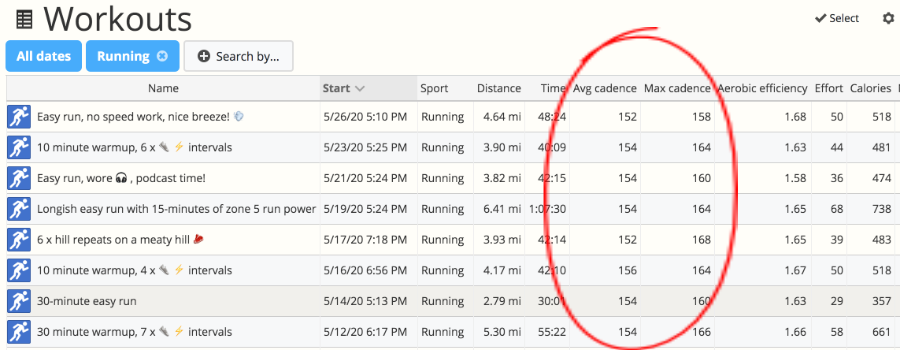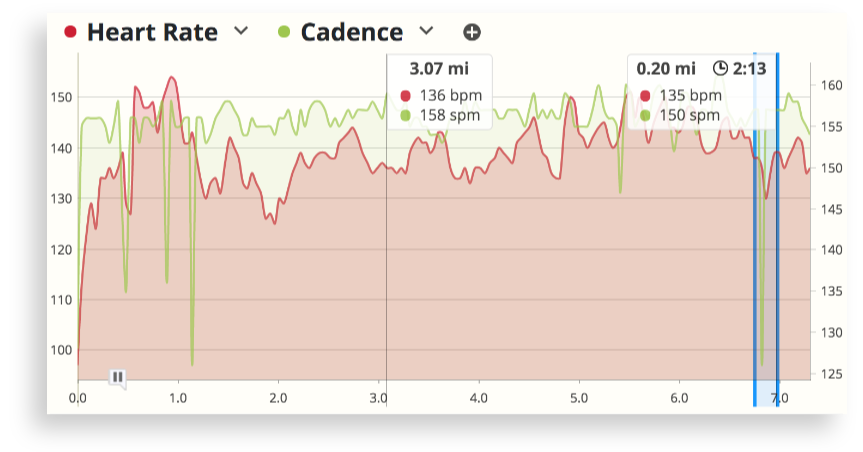What is good running cadence?
How to fully utilize fitness tech to train with cadence
In running, “cadence” is the number of steps you take per minute, and training to increase it is one of the most effective ways to improve your running form and efficiency. It's definitely worth your time to track, monitor, and analyze your cadence.
How to track cadence
Technology isn’t required to measure cadence. You can just count how many steps one leg takes in thirty seconds as you run, then multiply that number by four. However, the advantages of using tech are many:
- You can record your cadence every time you run with ease
- You can monitor your cadence in real-time
- You can record your entire run with various paces, ascents, and descents
- You can analyze your data to see how you’re performing over time
- You can see how your cadence relates to fatigue by overlaying heart-rate data
- It frees your mind from the monotony of counting 1, 2, 3, 4, 5, 6, 7...
The easiest way to track cadence is to wear a running watch. Most watches from Garmin, Polar, and other popular brands use built-in accelerometers to measure cadence. If you want the most accurate cadence data, you can pair an external Stryd footpod to your running watch. To view cadence data in real-time, many running watches let you customize your data screens, so you can see your cadence at a glance (and other metrics, too) while you run.
| NOTE: We have a separate article that has instructions on How to Improve Running Cadence |
What is a good running cadence number?
The average runner will have a cadence of 150 to 170 SPM (Steps Per Minute), while the fastest long-distance runners are up in the 180 to 200 SPM range. It's worth noting that these numbers are typically maintained in shorter-distance endurance races and full marathons.
Similar to SWOLF training for swimmers, your physical characteristics impact your cadence numbers. The length of your legs, your weight, and how tall you are all factors. Universally ideal cadence numbers do not exist, but, higher numbers are always something to strive for. However, don't boost up your cadence too quickly. Aim to improve gradually, with 5% increases over time.
...it's one sure-fire thing you can do to improve your form when running alone.
Improving your running form can be tricky if you don't have an experienced coach or colleague closely analyzing your gait, and it's difficult to judge the quality of your own form when you're running solo. That's why monitoring and analyzing your cadence data is so helpful; it's one sure-fire thing you can do to improve your form when running alone.
Improving your cadence also helps you avoid injuries. Overstriding is a major source of running-related injuries, and it occurs when your heel lands in front of your hips with an unbent knee. These punishing strides take longer to execute, so if you increase your cadence, you decrease the likelihood of overstriding. High cadence provides a smoother run, regardless of whether you're a heel-striker or a glider. There is less stress placed on your knees, hips, and back.
Post-workout data analysis
Monitoring your cadence as you run tells you how you're preforming in the moment, but analyzing your data later lets you to zoom-in to compare the fine details of your workout, and zoom-out to see the big picture of your fitness over time. You can identify trends in your training and take action — siezing every opportunity for improvement.
After your workout, hop onto your computer or mobile device to analyze your cadence data with SportTracks. These metrics are accessible in your Workout detail pages, and you can filter and list both your Average and Max cadence numbers by customizing your Workouts page:

Beside the cadence data in the image above is a metric called Aerobic Efficiency. It measures how well your cardiovascular system performed in relation to your heart rate. When you stack these numbers in a list over a period of time, you can determine if your efficiency is improving. Placing it beside your cadence data shows you how the two metrics interrelate.
Do you ever wonder if you maintain good running form as you get tired? Analyzing your cadence by overlaying your heartrate data can help you determine this, and you can look at runs with both short and long distances and intensities to see how your form holds up.

You can also visit your Analysis page and quickly put together custom charts that will display your cadence data in a variety of ways. Choose from pie charts, scatter plots, bubble grids and more, and compare this data on axis with heartrate, elevation gain, etc.
Cadence data is also closely related to a suite of advanced metrics called Running Dynamics. With specific Garmin watches and heartrate monitors, you can record Vertical Oscillation and Ground Contact Time, both of which you can analyze in SportTracks, and compare with your cadence data. The Stryd running power meter footpod records these metrics as well, supplying you with a wealth of efficiency metrics to analyze in SportTracks for every run.
Wrapping up
The great thing about cadence is that it's relatively simple. It's easy to gauge as you're running; you'll know in an instant how quickly you're turning over your feet. When you stack your cadence numbers in a list over a season, it's obvious to see how successful your training strategy turned out to be.
This is a case where a little understanding goes a long, long way. What would otherwise be just another meaningless data point is, in fact, a simple and clear indicator of your performance.
Thanks for reading this SportTracks blog post! If you have any insight to share, or questions about cadence, we would love to read them in the Comment section below...
| Article written by Sam Mallery, Director of Marketing, Zone Five Software Inc. |

Comments
If you do regular run/walk intervals, is there an easy way to track cadence on just your run intervals, over time?
Hey David!
Unfortunately, this is something SportTracks does not do at this time. However, a similar feature has been requested in the past. I recommned you visit the SportTracks User Voice page and vote it up:
https://sporttracks.uservoice.com/forums/201951-general/suggestions/6912634-active-laps-only-search-and-display-metrics
Since there is currently no mention of cadence, it would be best to add a comment to the feature request mentioning that cadence should be included as well.